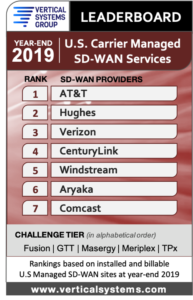
Over the past year, this blog series addressed some of the most critical topics surrounding the industry’s first SD-WAN standard, including the MEF SD-WAN services standard, associated certification program, and security vision and approach.
After a truly extraordinary series of events, led by a once-in-a-century global pandemic and buffeted by the election of a lifetime, there was a gap in this blog series, but we are back on track for 2021.
Looking back at the most extraordinary year in our collective lives, the MEF SD-WAN standard (MEF 70) has matured and evolved and begun to be adopted by several of the largest operators and vendors. However, SD-WAN market leaders experienced a revenue slow-down in the first half of the year, consistent with a decline in Enterprise Network Equipment Market. SD-WAN growth, which in 2019 exceeded 50%, has declined by an order of magnitude.
Despite the widely predicted surge in COVID-19 cases in the U.S., the outlook for 2021 is cautiously optimistic. The Dell’Oro group projects that the SD-WAN market will recover by 2022, with a five-year CAGR of 24% by 2025. However, employees working from home will resume, even after the pandemic wanes. In a recent survey of 250 Small to Medium Businesses (SMBs), IDC projects that 30% of the Work From Home (WFH) workers will return to their offices vs. 6% WFH employees pre-pandemic.
As we look ahead to 2021, and another step towards getting back to our everyday lives, this post offers lessons learned from collaborating with some of the world’s most prominent SD-WAN managed service providers and their vendors in certifying their services and products.
Major Operators are Onboard
Standards Development Organizations (SDOs), including MEF, certainly understand the criteria for success, which in a word is adoption. Of course, the primary challenge is how to drive and accelerate the implementation of the standard(s) to achieve the critical mass required for success. Borrowing a page out of MEF’s Carrier Ethernet’s playbook, just as the SD-WAN standard was being ratified (July 2019), the MEF established the MEF SD-WAN Certification program, with an explicit objective of driving awareness and adoption of the new standard.

In Q1’2020, MEF announced the first MEF SD-WAN certifications resulting from the pilot program.
By the summer, MEF ratified the SD-WAN Certified Test Requirements Standard (MEF 90), which motivated both leading SD-WAN Vendors and Managed Service Providers to become engaged as well.
By the end of 2020, certifications were performed for many of the world’s leading operators, including over half of the operators appearing on the Vertical Systems Group 2019 U.S. Carrier Managed SD-WAN Services Leaderboard (see Figure 1).
Top SD-WAN vendors have also certified their products, many of which are used by the market-leading MSPs. Three of the top five SD-WAN vendors for 2019 identified by Dell’Oro Group have certified their products as well, including VMware SD-WAN by VeloCloud, Versa Networks, and Fortinet.
Lessons Learned
After engaging with dozens of leading SD-WAN MSPs and vendors, the SD-WAN Authorized Certification Test Partner (ACTP) gleaned several learnings from the certifications:
Implementations are conforming: While the MEF project team responsible for standardizing surveyed the vendor community before completing work on the initial SD-WAN standard, the initial certifications motivated many changes to the MEF SD-WAN Certification Test Requirements. By the end of the year, many of the standards issues had been resolved, and the certification testing for both MSPs and vendors progressed more smoothly with fewer and fewer problems. Every single certification performed in 2020 was successful.
Vendors have taken distinct approaches: Ideally, standards specify the ‘What,’ but avoid constraining ‘How.’ In practice, the standard inevitably encroaches into the implementation domain, necessitating alterations to achieve the goal to be as inclusive as possible.
Amid the SD-WAN certifications, the vendors’ innovative approaches surfaced, resulting in a need to clarify and, in some cases, modify the requirements to enable individual products to conform. For instance, SD-WAN Virtual Connection Endpoints (SWVC-EPs, in MEF parlance) classify SD-WAN Application Flows and Flow Groups differently. SWVC-EP configuration also varies, which upon occasion affected conformance with the standard (but not always).
There are (too?) many options: In an attempt to support as many SD-WAN products as possible, all of which were shipping long before the SD-WAN standard was released, the MEF SD-WAN Service Standard ultimately included many optional requirements. This, in turn, hinders the ability to achieve multi-vendor interoperability.
Of the 90 test cases specified in the MEF SD-WAN Certification Test Requirements standard (MEF 90), only 11 test cases are Mandatory. The vast majority are ‘Feature-Required’ where test cases are required when an Optional feature is verified in the certification.
It (still) takes time for the paperwork: Upon reflecting on the certifications performed in 2020, the stage that took the longest to complete was not the planning nor the certification testing. Rather, the paperwork took an inordinate time to complete, especially for the largest organizations.
The certification requirements require that each MSP and vendor execute a MEF certification-specific agreement. Because of the unique nature of the deal, it took weeks and even months for some organizations to implement. This is an area that the ACTP and MEF will be revisiting in the months to come.
What’s Ahead in 2021
Even though SD-WAN experienced a speed bump in 2020, the stage is set to resume the torrid growth as we eagerly anticipate the new year. The MEF community is continuing to invest in the only MEF SD-WAN managed services standard, which is slated for a significant upgrade in 2021.
The SD-WAN Phase 2 revision (MEF 70.1) was released as a Draft Standard in Q3’2020 and expected to be ratified by Q2’2021. MEF 70.1 introduces new topology requirements, security, and performance and enhances the application flow and policy attributes.
As the SD-WAN service standard is upgraded, work has already commenced on the MEF SD-WAN Phase 2 Certification Program. The requirements analysis is well-underway, along with the detailed test case definition. The MEF SD-WAN Phase 2 Certification Program is targeted for introduction by the end of 2021 but is contingent upon the MEF 70.1 standard’s timely release.
Another significant standard targeted for release in 2021 is the MEF Application Security for SD-WAN Services (MEF 88), which was released as a Draft Standard in conjunction with MEF 70.1. MEF 88 specifies a series of security functions commonly deployed in an SD-WAN environment per the service framework established in MEF 70.1.
This standard represents the MEF’s initial foray into cyber-security and has resulted in additional SD-WAN security projects based on the SASE security architecture.
Closing Thoughts
SD-WAN continues to be the most essential and pervasive WAN initiative in the Cloud era. MEF has responded by enhancing the SD-WAN services framework while introducing relevant work in cyber-security. While a viable situation for many employers and their employees, WFH will never supplant the collaboration and all-important ad-hoc interactions offered by the workplace. Connectivity services are evolving to address the needs of the New Normal, with the MEF playing an essential role, especially for effective delivery of managed services.
Next up: We will provide a closer look at the SASE security architecture and how the MEF responds with a pair of new standards projects.
Other posts in the “Insights into MEF’s SD-WAN Standard” series:
- Part One: Overview (July 31, 2019)
- Part Two: Technical Approach (August 14, 2019)
- Part Three: Application Security Project (January 14, 2020)
- Part Four: MEF SD-WAN Certification Program (March 23, 2020)
